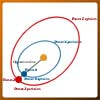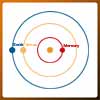You are seeing this message because you are using an out-of-date browser.
Please click here for more information.
Aphelion, Perihelion & Opposition
Aphelion, perihelion and opposition are just shorthand terms for expressing some very important concepts in astronomy. These words appear to be pretty strange at first glance, but they will soon become as familiar to you as the name of the street you live on.
Aphelion is the term astronomers use to describe the point in a planet's orbit where it is furthest away the Sun. Perhelion is the point in a planet's orbit where it is closest to the Sun. A planet is said to be in opposition with Earth when it is on a line drawn from the Sun through Earth to the planet.
During the Summer of 2003, we got a special treat when Mars was in opposition with Earth at the same time that it was at perhelion. By a favorable coincidence, Earth was at aphelion. The result of these three events happening at the same time was that Mars was closer to Earth than it had been in over 70,000 years. It was quite a sight to see!
Conjunction Junction, What's Your Function?
Apologies to Schoolhouse Rock, but it was just too good to pass up.
We're going to talk about the three basic types of planetary conjunctions, one of which you are probably already familiar with while the other two might be new to you. They aren't hard to understand and you will pick it up in a snap!
In technical terms, a conjunction occurs when two or more bodies appear in the sky within one degree of each other in the Zodiac. Put more simply, the bodies are very close to each other. Informally, we have come to call almost any close grouping of planets a conjunction. Basic planetary conjunctions are no more than an unusual grouping of two or more planets very close together in the sky. These happen all the time and regardless of what you might hear, pose no threat at all to those of us here on Earth. The Astronomy Picture of the Day site has a really beautiful image of a grouping that took place in the Spring of 2002.
The other types on conjunctions occur between Earth and either Mercury or Venus, which are the two planets closer to the Sun than we are. Either of those two planets are said to be in superior conjunction when they are on the same side of the Sun as Earth and are on a line drawn from Earth to the Sun. They are said to be at inferior conjunction when they are on the opposite side of the Sun from Earth and are on a line drawn from Earth through the Sun. The link at the right will take you to a chart that should help explain this visually.
This entire site copyright © 2003 Astronomy for Kids - all rights reserved



